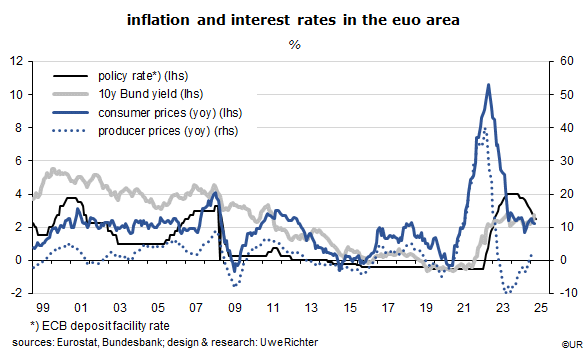
Market Commentary: The new trade war – the basics, seen from a European perspective
The U.S. administration has just raised customs duties on imports from the EU by a hefty 20 percentage points – and by 25 points on cars. Under the assumption that the volume of European exports to the U.S. will not decline much in response, this raises the cost of imports from the EU by about €120bn per year.
But the assumption that the volume of U.S. imports will not decline is not realistic: higher prices will lead to a significant reduction of European exports to the U.S.. Such an effect is actually the rationale behind the increase of American import duties. For Europe this means that overall demand for its goods, domestic and foreign, will fall, strengthening the recessionary forces that already exist. The so-called output gap will widen further, the rate of capacity utilization will fall.

In addition, Europe will quickly become the target of exporters from other countries who are also hit by higher U.S. import duties (e.g. 34% on imports from China) and are looking for alternative markets, such as Europe. Excess supplies meet weakening demand.
Workers will experience a deterioration of their negotiation powers – wage growth will slow which in turn means that household spending on goods and services is cooling. This puts further downward pressure on European inflation. For a long time, through five years of economic stagnation, the German labor market had been impressively resilient, but since last June the number of jobs has finally started to decline, if only very gradually so far; the unemployment rate, however, has gone up from a low of 5.0% in the second quarter of 2022 to 6.3% last month. The labor market situation is more or less the same in the rest of the EU.
In March, at 2.2% year-on-year, the Harmonized Index of Consumer Prices (HICP) had already been close to the ECB’s target of 2%. In the wake of the energy price explosion it had peaked at 10.6% in the autumn of 2022. Christine Lagarde, the president of the central bank had recently argued that policy rates were no longer restrictive; other board members had actually begun to suggest that a pause in the rate-cutting process might be needed. It had been 25 basis points per meeting, from 4.0% last summer to 2.5% now.
Since the economic outlook has suddenly worsened – with 2025 consensus real GDP growth expectations for the EU revised down to about 0.8% y/y or so –, the risk is now that inflation will undershoot its target once again. The euro area may be heading toward deflation.
Two other developments point in the same direction. Number one: the present downward revision of European companies’ future profits. This is triggering a stock market correction in the EU and the rest of the world, an increase of the cost of capital (equity), plus a negative wealth effect. Investment spending, the most volatile component of overall demand, will take a hit.

Number two: as in the financial crisis of 2007/2008, a comparable situation, the euro exchange rate has begun to rebound. International capital is attracted by the relatively low valuations of European equities, fairly sound government finances, the favorable outlook for inflation and the fear that the U.S. may suffer from stagflation going forward. Last time around, the euro had reached almost 1.60 dollars on foreign exchange markets; it is at $1.10 now. A repeat of such an appreciation would be a catastrophe, especially because China does not appear to let the yuan gain against the dollar – the yuan is thus increasingly undervalued.
On balance, euro area policy rates will probably be reduced by more than expected until recently. The ECB deposit facility rate is likely to fall further, and it cannot be excluded that it will reach about zero once again – unless the American president is forced to reverse course.
European fiscal policies will also become more expansionary than intended. Balanced budgets and lower deficits may soon no longer be top priorities.
Falling policy rates are good news for euro-denominated bonds while rising fiscal deficits are, as usual, bad news. Since the deficits are not caused by reckless spending or tax cuts, the combination of falling inflation and policy rates will probably be the dominant force for European bonds. For the time being at least, they are likely to become the ultimate safe haven, replacing gold: Europeans in particular don’t need gold as an inflation hedge anymore. Crude oil prices will remain under downward pressure in the present recessionary global environment as well. What about European stock markets? They will be boosted by falling interest rates while suffering from the euro’s appreciation and the slowdown of economic growth; in relative terms they remain rather cheap – but are not yet a buy as the bear market has only just begun.
About Wermuth Asset Management
Wermuth Asset Management (WAM) is a Family Office which also acts as a BAFIN-regulated investment consultant.
The company specializes in climate impact investments across all asset classes, with a focus on EU “exponential organizations” as defined by Singularity University, i.e., companies which solve a major problem of humanity profitably and can grow exponentially. Through private equity, listed assets, infrastructure and real assets, the company invests through its own funds and third-party funds. WAM adheres to the UN Principles of Responsible Investing (UNPRI) and UN Compact and is a member of the Institutional Investor Group on Climate Change (IIGCC), the Global Impact Investing Network (GIIN) and the Divest-Invest Movement.
Jochen Wermuth founded WAM in 1999. He is a German climate impact investor who served on the steering committee of “Europeans for Divest Invest”. Jochen was on the founding investment committee of Germany’s SWF KENFO from June 2017 until February 2024.
Legal Disclaimer
The information contained in this document is for informational purposes only and does not constitute investment advice. The opinions and valuations contained in this document are subject to change and reflect the viewpoint of Wermuth Asset Management in the current economic environment. No liability is assumed for the accuracy and completeness of the information. Past performance is not a reliable indication of current or future developments. The financial instruments mentioned are for illustrative purposes only and should not be construed as a direct offer or investment recommendation or advice. The securities listed have been selected from the universe of securities covered by the portfolio managers to assist the reader in better understanding the issues presented and do not necessarily form part of any portfolio or constitute recommendations by the portfolio managers. There is no guarantee that forecasts will occur.
Read the full article in PDF format here: English.